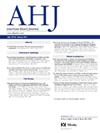Implementing remote patient monitoring to improve hypertension control in a primary care network: Rationale and design of the monitor-BP Cluster Randomized Trial
IF 3.7
2区 医学
Q1 CARDIAC & CARDIOVASCULAR SYSTEMS
引用次数: 0
Abstract
Background
Home blood pressure monitoring with clinical or technological support (Supported HBPM) is an evidence-based intervention recommended by national guidelines for improving hypertension (HTN) control. However, few healthcare systems have implemented Supported HBPM because it remains unclear how best to promote uptake among patients and clinicians, and the real-world effectiveness of Supported HBPM is unknown. The Monitor-BP Trial aims to determine the impact of implementing a flexible Supported HBPM program on practice-level HTN control and to evaluate the reach, adoption, maintenance, and cost-effectiveness of the program in a socioeconomically diverse primary care network.
Methods
The Monitor-BP Trial takes place in 15 primary care practices affiliated with two large academic medical centers in New York City. It is a hybrid 2 effectiveness-implementation cluster randomized pre-post trial testing early implementation of a Supported HBPM program (8 practices) versus usual care (7 practices). Adult patients with diagnosed HTN and their primary care clinicians are eligible for inclusion. The intervention consists of two program options: (1) MyCare Hypertension, a low resource intensity option in which patients use their own BP devices to track home BP in the online patient portal with automated triage support for extreme readings and portal-delivered educational modules, (2) RPM Hypertension, a high resource intensity option in which patients are loaned wireless BP devices that automatically transmit home BP data to the electronic health record (EHR) with telehealth navigator onboarding and nursing support to triage extreme readings. Both options include EHR-integrated ordering and home BP data visualization for clinicians. Key features of the implementation strategy include clinician education and training via presentations, clinician prompts and reminders via e-mails and mailed postcards, detailed instructional materials for patients and clinicians via websites, and at least monthly problem-solving meetings with clinical champions to iteratively tailor implementation to individual practices. The primary effectiveness outcome is practice-level pre- to post-implementation change in the mean 12-month change in office systolic BP among patients with uncontrolled office BP at baseline. The primary implementation outcomes are reach (uptake of the Supported HBPM program by patients) and adoption (uptake of the Supported HBPM program by clinicians). Secondary outcomes include estimating the short- and long-term cost-effectiveness of the program.
Conclusions
The Monitor-BP Trial tests a scalable approach to implementing telemonitoring-enabled Supported HBPM interventions into real-world clinical settings. Our findings have the potential to inform how health systems can shift the paradigm of BP assessments from the office to the home.
在初级保健网络中实施患者远程监测以改善高血压控制:监测仪-血压随机分组试验的原理和设计
背景:在临床或技术支持下进行家庭血压监测(支持性HBPM)是国家高血压控制指南推荐的一种循证干预措施。然而,很少有医疗保健系统实施了支持性HBPM,因为目前尚不清楚如何最好地促进患者和临床医生的吸收,并且支持性HBPM的实际有效性尚不清楚。监测-血压试验旨在确定实施灵活的支持性HBPM项目对实践水平HTN控制的影响,并评估该项目在社会经济多样化的初级保健网络中的覆盖范围、采用、维护和成本效益。方法:监测血压试验在纽约市两家大型学术医疗中心的15家初级保健诊所进行。这是一个混合的有效性-实施集群随机试验前-后测试支持HBPM计划的早期实施(8个实践)与常规护理(7个实践)。诊断为HTN的成年患者及其初级保健临床医生有资格纳入研究。干预包括两个方案选择:(1) MyCare Hypertension,这是一种低资源强度的选择,患者可以使用自己的血压设备在在线患者门户网站上跟踪家庭血压,支持极端读数和门户网站提供的教育模块的自动分诊;这是一种高资源强度的选择,患者可以借用无线血压设备,自动将家庭血压数据传输到电子健康记录(EHR),配备远程医疗导航仪和护理支持,以分类极端读数。这两种选择都包括ehr集成订购和临床医生的家庭血压数据可视化。实施策略的主要特点包括:通过演示对临床医生进行教育和培训,通过电子邮件和邮寄明信片对临床医生进行提示和提醒,通过网站为患者和临床医生提供详细的指导材料,以及至少每月与临床专家举行一次解决问题的会议,以迭代地为个人实践量身定制实施方案。主要疗效指标是在基线血压不受控制的患者中,实施前至实施后12个月办公室收缩压平均变化的实践水平变化。主要实施结果是达到(患者接受支持的HBPM计划)和采用(临床医生接受支持的HBPM计划)。次要结果包括评估项目的短期和长期成本效益。监测-血压试验测试了一种可扩展的方法,将远程监测支持的HBPM干预措施应用于现实世界的临床环境。我们的研究结果有可能告诉卫生系统如何将BP评估范式从办公室转移到家庭。
本文章由计算机程序翻译,如有差异,请以英文原文为准。
求助全文
约1分钟内获得全文
求助全文
来源期刊

American heart journal
医学-心血管系统
CiteScore
8.20
自引率
2.10%
发文量
214
审稿时长
38 days
期刊介绍:
The American Heart Journal will consider for publication suitable articles on topics pertaining to the broad discipline of cardiovascular disease. Our goal is to provide the reader primary investigation, scholarly review, and opinion concerning the practice of cardiovascular medicine. We especially encourage submission of 3 types of reports that are not frequently seen in cardiovascular journals: negative clinical studies, reports on study designs, and studies involving the organization of medical care. The Journal does not accept individual case reports or original articles involving bench laboratory or animal research.
 求助内容:
求助内容: 应助结果提醒方式:
应助结果提醒方式:


